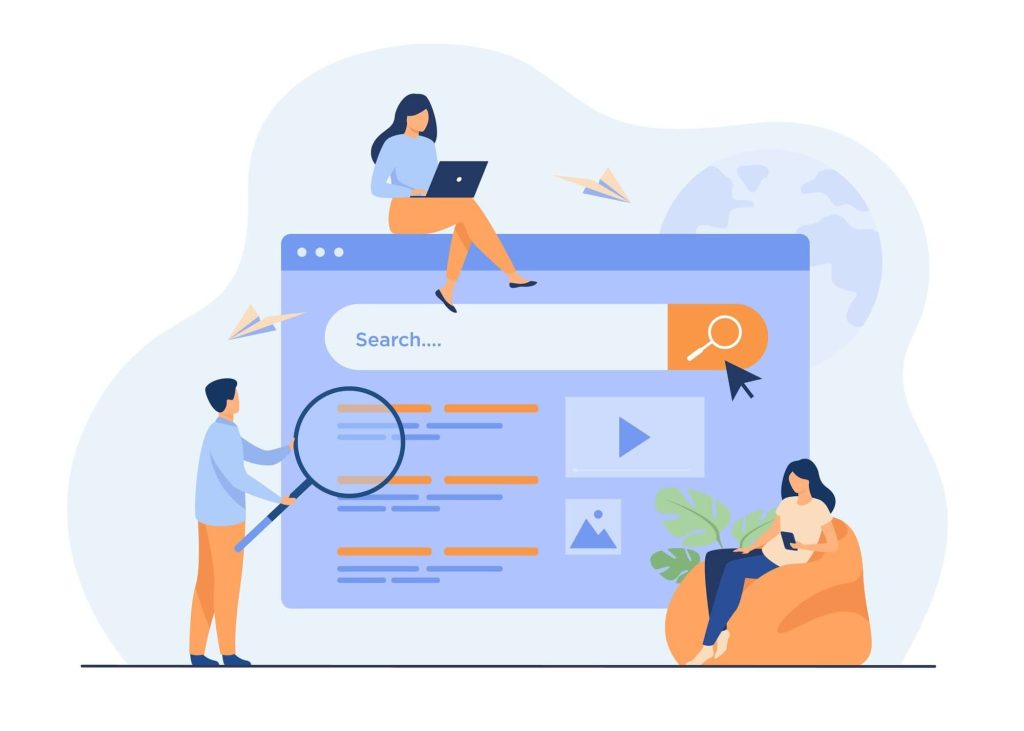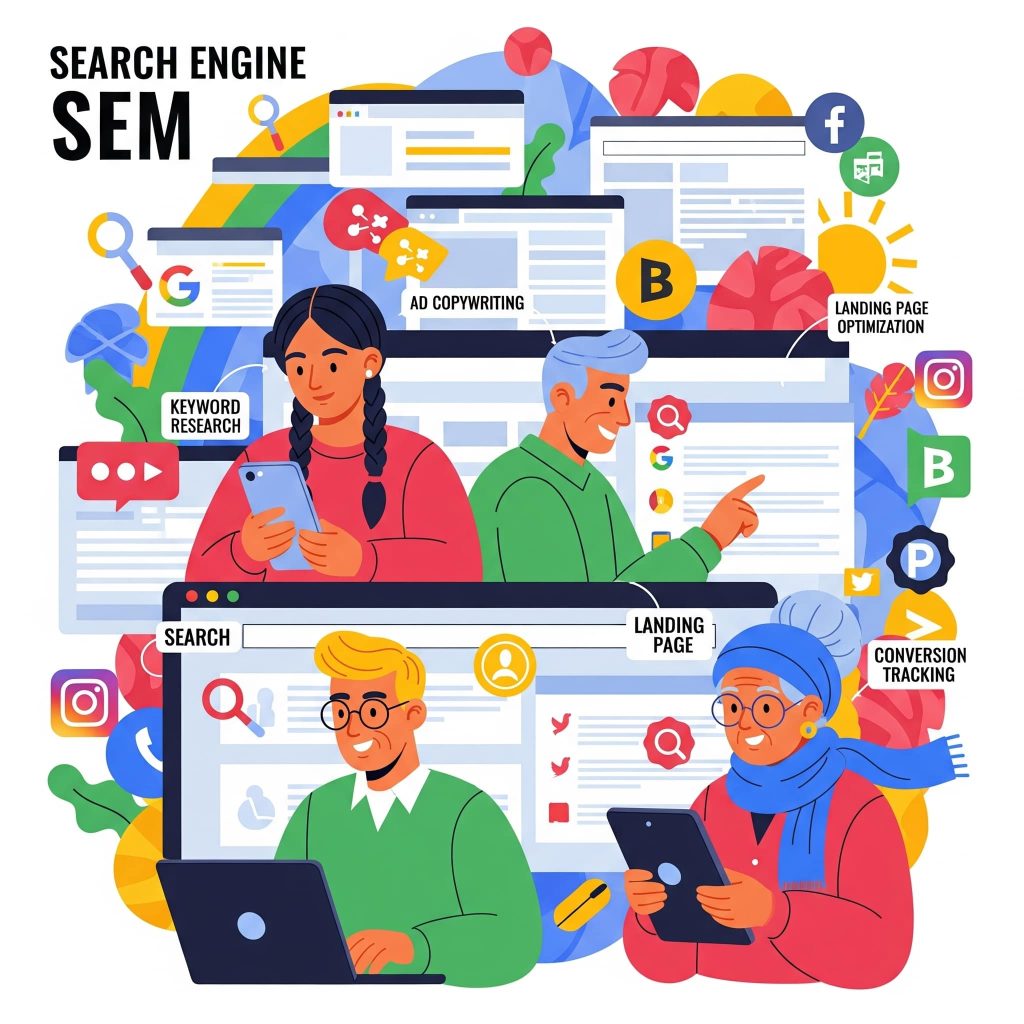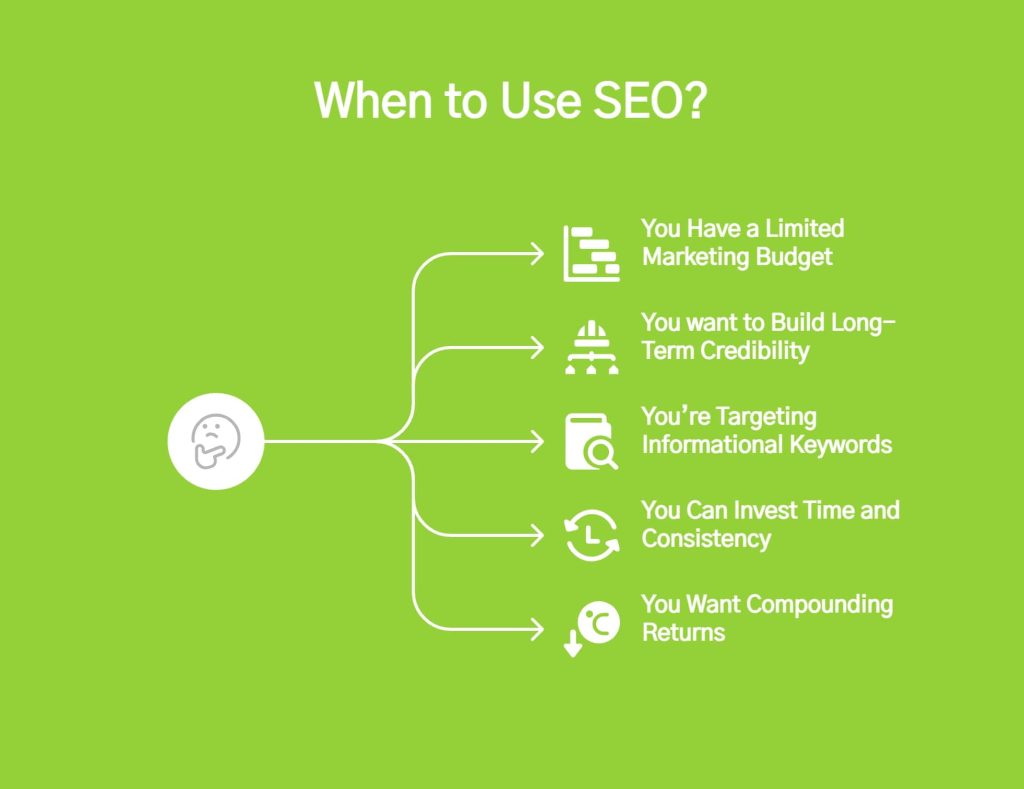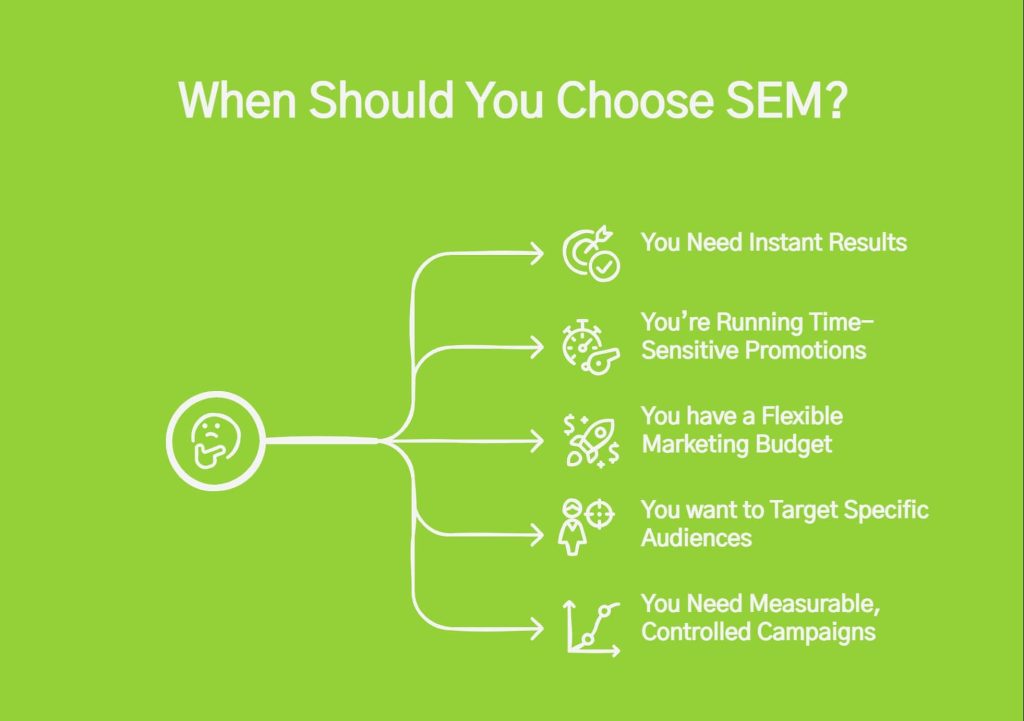Confused between SEO and SEM? You’re not the only one staring at marketing dashboards wondering where to put your next rupee.
Every business wants to show up on Google, but should you wait for organic traffic to build over time, or pay for instant visibility? That’s the million-rupee question.
With competition rising and attention spans shrinking, choosing the right strategy isn’t just smart; it’s survival. But while both aim to boost your search visibility, they work in very different ways.
If you’re asking yourself as an entrepreneur or a new business owner, ‘Which one is better for my website?” keep reading to get the full juice. By the end of this blog, you’ll have a clear understanding of the seo/sem difference, and know exactly which strategy suits your business best.
What is SEO?

Illustration of SEO
SEO, or Search Engine Optimisation, is the practice of improving your website’s visibility in organic search results on platforms like Google Search. The goal of SEO is simple: to attract free, relevant traffic by ranking higher on the first page of Google for the keywords your target audience is searching for.
Unlike search ads or PPC campaigns, SEO focuses on earning clicks, not paying for them. It’s especially valuable for small businesses or anyone working with a limited marketing budget.
How Does SEO Work?
SEO works by aligning your website with what search engines (like Google) look for when showing results. The more relevant and trustworthy your site appears, the higher it ranks in organic search results.
Here’s how it typically works:
- Keyword Research: Identify the words your target audience is searching for using tools like Google Keyword Planner or Ahrefs.
- Content Optimisation: Create valuable, well-structured content that matches search intent.
- On-page SEO: Use relevant keywords, proper headings, and internal linking.
- Technical SEO: Improve site speed, mobile-friendliness, and structured data for better search engine visibility.
- Off-page SEO: Build backlinks from reputable websites to boost your authority.
It takes a lot of time, consistency, and testing, but the long-term results are worth it.
What is SEM?

Illustration of SEM
SEM, or Search Engine Marketing, is a form of advertising that helps your business appear in the paid search results of platforms like Google’s search results and Bing. Unlike organic results, SEM lets you reach your target audience almost instantly through PPC (Pay-Per-Click) ads.
The core idea is simple: you bid on keywords, and your ads appear when someone searches for them. You only pay when someone clicks on your ad, making it a cost-effective strategy when done right.
How Does SEM Work?
SEM works by placing your ads in front of people actively searching for what you offer, using platforms like Google Ads or Bing Ads.
Here’s how it works step-by-step:
- Keyword Targeting: Choose the right keywords based on search volume and buyer intent.
- Ad Creation: Write compelling ad copy and design effective landing pages that drive conversions.
- Bidding: Set bids for your selected keywords; your ad placement depends on your quality score and average CPC.
- Audience Targeting: Reach users based on location, device, demographics, or behaviour.
- Performance Tracking: Monitor clicks, conversions, and cost using tools like the Google Ads dashboard.
A well-run SEM campaign can place your brand at the top of SERPs in just hours.
Key Difference Between SEO and SEM in Digital Marketing
Now that you have a fair idea about SEO and SEM, let’s address the real question: which one’s right for you?
Both strategies aim to boost your search engine visibility, but the way they work, the time they take, and what they cost are completely different. To help you make an informed choice, here’s a clear, side-by-side breakdown of the most significant differences between SEO and SEM:
| Aspect | SEO (Search Engine Optimisation) | SEM (Search Engine Marketing) |
| Type of Traffic | Organic traffic (free clicks from Google’s search results) | Paid traffic (via PPC ads or search ads) |
| Cost | No cost per click, but requires time and effort | Pay-per-click (PPC); you pay for each visitor |
| Speed of Results | Takes time, weeks or months of testing to see results | Quick results, visibility can start in a few hours |
| Placement on SERPs | Appears below or after ads in organic search results | Appears at the top of SERPs in the paid search results |
| Long-Term Value | Long-lasting if maintained; great for positive ROI over time | Short-term, works as long as you’re paying |
| Best For | Brands with a limited marketing budget and long-term growth goals | Businesses needing immediate traffic or promoting offers |
| Content Focus | Needs informational keywords, blogs, and website content | Focus on ad copy, promotions, and landing pages |
| Tools Used | Google Search Console, Ahrefs, SEMrush, Yoast | Google Ads, Keyword Planner, SEMrush |
| Audience Targeting | Based on search intent and keyword relevance | Highly specific audience targeting by location, device, etc. |
| Control & Flexibility | Less direct control over traffic and rankings | More control over budget, targeting, and ad creation |
| Part of Search Marketing? | Yes, SEO is a part of SEM | SEM includes SEO + paid search advertising |
Still confused? Let’s take a closer look at the pros and cons of SEO and SEM to help you decide which strategy aligns best with your goals.
The Bright Side and Blind Spots of SEO
SEO is a powerful tool in your digital marketing strategy, but like any long-term investment, it comes with both advantages and limitations.
| Pros of SEO | Cons of SEO |
| Cost-Effective in the Long Run | Takes Time to Show Results |
| Builds Trust and Authority | Constant Algorithm Changes |
| Sustainable Results | Ongoing Effort Needed |
| Drives Consistent Website Visitors | High Competition |
| Better ROI Over Time | No Guaranteed Rankings |
SEM Advantages and Drawbacks You Should Know
If your business needs instant visibility, quick results, or you’re testing a new product or offer, SEM might be your best bet. But like any form of advertising, it comes with trade-offs. Let’s look at the pros and cons:
| Advantages of SEM | Drawbacks of SEM |
| Fast Visibility on Google | Can Get Expensive Quickly |
| Precise Audience Targeting | Temporary Traffic |
| Full Control Over Budget and Messaging | Click Fraud Risks |
| Data-Rich Insights | Requires Constant Monitoring |
| Great for Limited-Time Offers | Not Ideal for Small Budgets |
When to Use SEO?

Infographic on when to choose SEO
Still wondering if SEO is the right move for your business? If you’re playing the long game and want to build lasting visibility without spending on every click, SEO is a smart investment.
Here’s when SEO makes the most sense:
- You Have a Limited Marketing Budget: Unlike PPC, SEO lets you grow without paying for every visitor.
- You want to Build Long-Term Credibility: Appearing in organic search results tells users that Google trusts your content.
- You’re Targeting Informational Keywords: If your audience is searching for guides, how-tos, or blog content, SEO delivers.
- You Can Invest Time and Consistency: SEO takes effort, but it brings sustainable traffic if you’re patient.
- You Want Compounding Returns: Over time, good SEO can snowball into more rankings, more clicks, and better ROI.
In short, if you’re focused on content-led growth, organic traffic, and have the patience for gradual but strong results, SEO should be a core part of your digital marketing strategy.
When Should You Choose SEM?

Infographic on when to choose SEM
Need traffic fast? Launching a new product or offer? That’s when SEM can be your best friend. Unlike SEO, which takes time to build momentum, SEM gives you immediate visibility on search engines, perfect for businesses that need quick wins.
Here’s when it makes sense to invest in SEM:
- You Need Instant Results: Your ads can appear on top of SERPs within hours of launching.
- You’re Running Time-Sensitive Promotions: Ideal for festive sales, limited-time offers, or new launches.
- You have a Flexible Marketing Budget: Great for brands ready to invest and test different PPC campaigns.
- You want to Target Specific Audiences: SEM lets you narrow down by location, device, demographics, and even search intent.
- You Need Measurable, Controlled Campaigns: Track every click, test different ad copy, and tweak your strategy in real time.
If you want to be where your customers are searching instantly, SEM might just be your best bet.
Is it Better to Use SEO and SEM Together?
Yes, there are indeed massive differences between SEO and SEM, but a combination of both tends to work marvelously for your digital marketing efforts. Here’s how they can join hands:
- SERP Visibility: When customers look for products/services on search engines, SEO & SEM work together to give them the best results. Some companies use them in tandem to appear multiple times on SERPs.
- Keyword Research (KR): SEO & SEM give results depending on the relevance of keywords searched for. So when used together using KR, the ROI, especially for new websites, can be quite spectacular.
- One for the Other: Sometimes, results from an SEM effort can give valuable data points (like keyword performance, conversion rates, etc.) on how to approach an eventual SEO strategy.
SEO or SEM? Let Wild Creek Web Studio Guide You to the Right Choice
Choosing between SEO and SEM isn’t just a marketing decision; it’s a business move that can impact your growth, visibility, and ROI. At Wild Creek Web Studio, we don’t offer one-size-fits-all solutions. We take the time to understand your goals, audience, and budget to craft a search marketing strategy that actually works.
Whether you need the long-term gains of SEO or the instant visibility of SEM, our team ensures you invest smartly, not blindly. With proven results across industries, we help brands cut through the noise and show up where it matters most, on Google.
Contact us today and let’s build the right growth path for your business.
Conclusion
In the ever-evolving world of digital marketing, understanding the SEM and SEO difference can save you both time and money. SEO is a marathon, perfect for those who want lasting visibility without paying for every click. SEM, on the other hand, is a sprint, ideal when you need immediate results or are testing new waters.
There’s no one-size-fits-all answer, but now you know when to choose what. Whether you’re running a startup, scaling a business, or launching a campaign, align your strategy with your goals, budget, and timeline. And remember, when done right, combining both can give you a powerful edge on Google’s search results.
Frequently Asked Questions
Which one costs more, SEO or SEM?
In most cases, SEM costs more upfront since it involves paying for ads. SEO is often less expensive long-term, but requires time, effort, and consistency. That’s a key difference between SEO and SEM.
Is SEO or SEM more important?
Both are important depending on your goals. SEO builds long-term visibility, while SEM offers immediate traffic. The SEM and SEO difference lies in strategy, SEO is a marathon, SEM is a sprint. Ideally, use both together.
Which is paid, SEO or SEM?
SEM is the paid approach, think Google Ads or PPC campaigns. SEO is organic and doesn’t involve direct ad spend. One core difference between SEO and SEM is that SEM includes paid placements, while SEO does not.
Is SEM more immediate than SEO?
Yes, SEM delivers results almost instantly with paid ads. SEO takes time to rank organically. So, when it comes to speed, SEM wins. That’s another important SEM and SEO difference to consider for your strategy.
What are the 4 types of SEO?
The four main types of SEO are: On-page SEO, Off-page SEO, Technical SEO, and Local SEO. Mastering these areas helps you succeed organically, without relying on paid SEM efforts.
